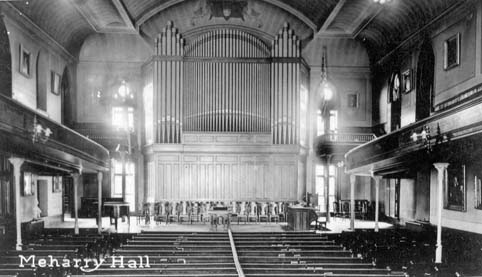
|
Pages: << Back 1 2 3 4 5 6 7 8 9 10 Next >>
The next year Lucy Rowland Hall, named for Rector's widow, was constructed on the site of Music Hall, which was moved catty-corner to a new location next to Bowman Gymnasium on Hanna Street. (There, provided with a basement and a frame annex in the rear, the relocated building continued to house the School of Music for nearly a half century longer.) The construction of the new dormitory adjacent to Mansfield and Rector Halls created a residential quadrangle which housed freshman women as well as upperclass non-affiliated women.
Both
Lucy Rowland and Longden Halls were designed in his usual Beaux
Arts eclectic style by architect Robert F. Daggett. In 1927 Katherine
M. Mills became responsible for the oversight of these facilities
as director of residence balls. Longden Hall became the center of
the activities of Men's Hall Association, an organization of independent
men founded a few years before by a group of Florence Hall residents.
M.H.A. soon became a significant force on campus, hitherto dominated
by the Greek-letter social fraternities. For several decades the
independent organization competed actively in intramural athletics,
student politics, and social activities. No such alternative to
sorority affiliation seems to have existed at this time.
The
Murlin presidency, brief as it was, covered an eventful, transitional
period in DePauw's history. In 1928 the quiet but effective administrator,
after experiencing repeated bouts of illness and encountering some
opposition to his policies, reluctantly submitted his resignation
to the board of trustees. He later served for a time as pastor of
the American Church in Berlin and died in 1935. His widow bequeathed
his library to the university, together with a small endowment to
support the presidential office.
President G. Bromley Oxnam, his wife Ruth Fisher
Oxnam, G. Bromley Oxnam, whom the trustees chose as Murlin's successor, was a quite different sort of college president than any of his predecessors. A graduate of the University of Southern California and the Boston University School of Theology, he had served as pastor of a large Los Angeles church before becoming professor of social ethics at Boston University. A vigorous, charismatic person, with strong convictions and a forceful speaking style, Oxnam was to achieve a high level of national and international recognition and bring DePauw an unprecedented amount of public attention during his presidential term. After taking up residence in Greencastle he not only continued his ardent advocacy of world peace and social reform but also proved to be an activist administrator bent on remolding the university in accordance with his own views.
The
financial crash of 1929 and the ensuing depression created major
problems for the university. Endowment income was reduced severely
together with revenue from student fees as enrollment rapidly declined.
The student population fell to 1600 by 1932 and dropped to the 1200
level during the mid-1930s. Despite draconian measures undertaken
to balance the budget, including raising tuition fees and trimming
salaries, the university books once more recorded annual deficits.
Under the leadership of its president, Roy O. West, the board of
trustees restructured the university's investments in an attempt
to increase revenue. Real estate holdings that were producing poor
returns were liquidated in favor of high-grade bonds and similar
securities promising higher current income. By means of such measures
DePauw managed to weather the economic storms of the period.
The
College Avenue church, also minus its steeple, was stuccoed and
remodeled into Speech Hall, which survived for five decades as the
home of the Little Theatre and the speech and education departments.
The university had originally planned to erect a building in conjunction
with the new church which would house both the latter's educational
facilities and DePauw's departments of English Bible, philosophy,
and religious education and bear the name of its late president,
Hillary A. Gobin. When this project proved financially unfeasible,
the newly merged congregation agreed to name its new edifice the
Gobin Memorial Methodist Church in consideration of DePauw's help
in paying off the building debt. In turn DePauw was permitted use
of the sanctuary for chapel and similar services. While Gobin Church's
architectural style and yellow-brick exterior did not harmonize
closely with most of the academic buildings, the cathedral-like
structure was conveniently located and came to be regarded as virtually
an integral part of the
______________________________ |
Depauw University e-history | E-mail comments to: archives@depauw.edu

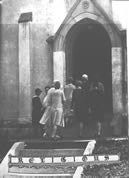
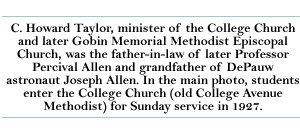
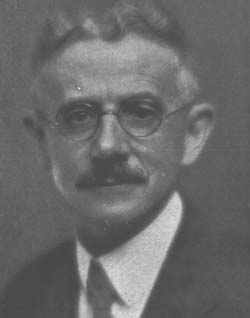



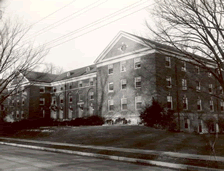
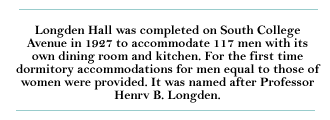
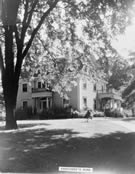
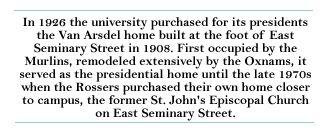
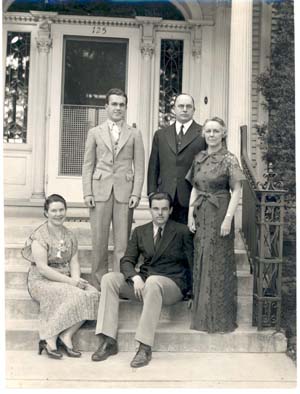
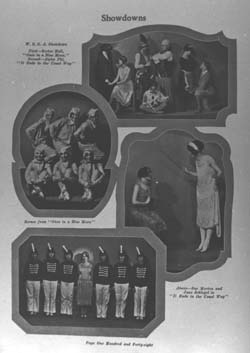
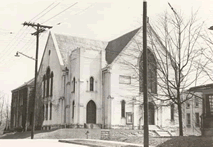
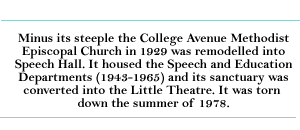
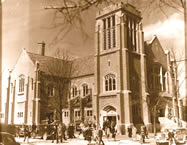
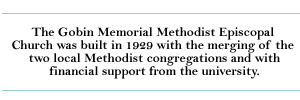
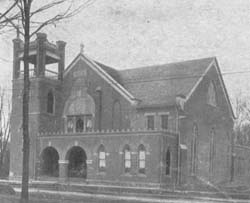 _______________________________
_______________________________